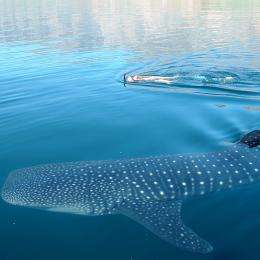Emerging whale shark 'crisis' in China

A study involving Murdoch University and Shandong University at Weihai has found distressing trends in the catch and trade of threatened whale sharks in China.
Results indicate whale sharks are increasingly being targeted due to high demand for large shark fins and a rising appetite for shark meat in general.
“There is no targeted whale shark fishery in China at the moment, although with the high prices now being paid for shark fins, this is likely to change,” said Brad Norman of Murdoch’s Centre for Fish, Fisheries and Aquatic Ecosystems Research.
“While whale sharks are covered by law in China as a second-class national protected animal, catches are generally unmonitored and trade is uncontrolled, similar to other shark species.”
Mr. Norman and his collaborators surveyed more than 2500 fishermen in 27 fishing harbours in eight coastal provinces. They also conducted field-based interviews in Puqi, Zhejiang province, known as the shark processing base of China.
“Fins are the most expensive shark product, but liver oil, lips, cartilage, skin, brain, stomach and meat are now important commodities, supporting expanding consumption at the domestic level,” Mr. Norman said.
“Puqi has 20 local seafood restaurants that feature a ‘shark feast’, marketed on nutritional value, which is making the city a famous attraction for tourists. This means competition for large-sized sharks remains fierce.”
Mr. Norman said fishery enforcement personnel have paid little attention to direct and incidental captures and often incorrectly informed fishermen that whale sharks were not a protected species.
“Our findings are preliminary, but they strongly indicate an emerging crisis for whale sharks in China,” he said.
Mr. Norman added this situation has a potential knock-on effect for Western Australia, including at Ningaloo Marine Park, where his affiliate not-for-profit group ECOCEAN continues to monitor a thriving ecotourism industry for the animals.
“Whale sharks are highly migratory, though these migration patterns are poorly understood. Limited tracking studies have shown they can travel thousands of kilometres. While they are protected in Australia, once they leave our waters, they’re at risk of being hunted.”
Provided by Murdoch University















